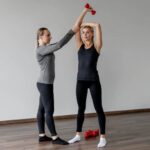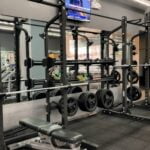Plank exercises have become a staple in fitness routines for their ability to target multiple muscle groups and improve overall strength and stability. In this article, we will delve into the world of fitness exercises plank, exploring what makes this exercise so effective and beneficial for both physical and mental health.
So, what exactly is a plank? A plank is a simple yet powerful bodyweight exercise that involves maintaining a static position while supporting your body on your forearms and toes. It primarily targets the core muscles but also engages the arms, back, and legs, making it a comprehensive full-body workout. The beauty of planks lies in their versatility – they can be modified to suit different fitness levels and goals.
Beyond the physical benefits, plank exercises also offer mental advantages such as improved focus, discipline, and resilience. By challenging yourself to hold a plank position for an extended period, you not only strengthen your muscles but also enhance your mental toughness and endurance.
In the following sections, we will explore in detail the various benefits of incorporating plank exercises into your regular fitness routine, proper form and technique guidelines, muscle groups targeted, common mistakes to avoid, and advanced variations to keep your workouts exciting.
Benefits of Plank Exercises
Plank exercises offer a multitude of both physical and mental benefits that make them an essential component of any fitness routine. By holding a plank position, you engage multiple muscle groups simultaneously, ultimately strengthening your core, arms, legs, and back. This full-body workout not only helps improve balance and stability but also enhances overall muscle tone. Additionally, planks can aid in improving posture, reducing the risk of back pain, and increasing flexibility.
To further highlight the benefits of incorporating plank exercises into your fitness routine, here are some key advantages:
- Improved Core Strength: Planks target the abdominal muscles, including the rectus abdominis and obliques. Strengthening these muscle groups can lead to better posture and reduced risk of lower back pain.
- Enhanced Stability: By engaging the muscles in your shoulders, arms, and lower body, planks help improve overall stability. This increased stability can benefit various daily activities and sports performance.
- Mental Endurance: Holding a plank position for an extended period requires focus and mental strength. Regularly practicing planks can help boost mental endurance and discipline.
Incorporating plank exercises into your workout routine not only offers physical benefits but also has a positive impact on your mental well-being. Whether you’re a beginner or an experienced fitness enthusiast, adding planks to your regimen can elevate your overall fitness level and contribute to a healthier lifestyle.
Proper Form and Technique
Plank exercises are a popular choice for those looking to strengthen their core muscles and improve overall fitness levels. Whether you’re a beginner or an experienced fitness enthusiast, mastering the proper form and technique of a plank is essential for reaping its benefits. Here is a step-by-step guide on how to perform a perfect plank, along with variations for different fitness levels:
- Basic Plank: Start by getting into a push-up position, but with your weight resting on your forearms instead of your hands. Keep your body in a straight line from head to heels, engaging your core muscles throughout the exercise. Hold this position for as long as you can while maintaining proper form.
- Modified Plank: For beginners or those with lower back issues, you can perform a modified version of the plank by dropping your knees to the ground while still keeping your core engaged. This reduces the amount of weight on your upper body while still providing an effective workout for your core muscles.
- Advanced Plank: To challenge yourself further, try adding variations like side planks, spider planks, or plank jacks to target different muscle groups and increase overall strength and stability.
Practicing proper form and technique during plank exercises is crucial to prevent injury and maximize results. Remember to keep your body aligned, engage your core muscles, and avoid these common mistakes:
- Sagging Hips: Ensure that hips are not drooping towards the floor, as this can strain the lower back.
- Raised Hips: Avoid lifting your hips too high, which can disengage the core muscles and reduce effectiveness.
- Incorrect Hand Placement: Place your elbows directly beneath your shoulders and maintain a neutral spine alignment throughout the exercise.
By following these tips and practicing regularly, you can master the plank exercise and reap its many benefits for overall strength, stability, and endurance. Incorporating plank variations into your workout routine can help challenge different muscle groups and keep things interesting while working towards achieving your fitness goals. Start with basic planks and gradually progress to more advanced variations as you build strength and confidence in your abilities.
Muscle Groups Targeted
Plank exercises are a versatile and effective way to engage multiple muscle groups simultaneously. When performed correctly, planks primarily target the core muscles, including the rectus abdominis, transverse abdominis, and obliques. These muscles play a crucial role in stabilizing the spine and pelvis, supporting proper posture, and improving overall functional movement.
Core Muscles
The plank is known for its ability to engage and strengthen the core muscles. The rectus abdominis, commonly referred to as the “six-pack” muscles, work to stabilize the spine during a plank. The transverse abdominis, which acts like a natural girdle around the abdomen, also gets activated to help maintain proper alignment and support. Additionally, the obliques on the sides of the waist assist in rotational movements while holding a plank position.
Back Muscles
While focusing on core strength, planks also engage the back muscles, including the erector spinae that run along the spine. These muscles help in maintaining a neutral spine position during a plank exercise while supporting the entire back to prevent injuries and promote spinal health.
Arm and Leg Muscles
Apart from targeting the core and back muscles, planks can also engage the arms and legs to some extent. While holding a plank position, the arms (particularly shoulders) are actively working to support your body weight. Similarly, your leg muscles – quads, hamstrings, and calves – are engaged to keep your body aligned in a straight line from head to heels.
This full-body engagement makes planks an excellent exercise for building overall strength and stability. Incorporating different variations of planks can further challenge these muscle groups for more comprehensive strengthening benefits.
Incorporating plank exercises into your regular fitness routine can help you develop stronger core muscles as well as improve overall body strength and endurance. Whether you’re looking to enhance your posture or boost athletic performance, adding planks into your workouts can bring about significant improvements in various aspects of fitness.
So next time you hit the gym or workout at home, don’t forget to include some plank variations for a well-rounded workout routine that targets multiple muscle groups concurrently.
Common Mistakes to Avoid
Plank exercises are a fantastic way to engage multiple muscle groups, including the core, back, arms, and legs. However, like any fitness routine, there are common mistakes that people often make while performing planks.
One of the most frequent errors is allowing your hips to sag or sticking your bottom up in the air, compromising the effectiveness of the exercise. To correct this mistake and achieve optimal results, focus on maintaining a straight line from your head to your heels by engaging your core muscles throughout the plank.
Another common mistake during planks is placing your hands too far forward, which can put unnecessary strain on your shoulders and wrists. To avoid this error, ensure that your hands are directly underneath your shoulders when in plank position. This alignment not only helps prevent injury but also allows you to better engage your core muscles for maximum benefit. Remember that proper form is key to getting the most out of your workout.
Lastly, rushing through planks without proper breath control can hinder their effectiveness. Holding your breath or breathing rapidly can increase stress on your body and make it harder to maintain good form.
Instead, focus on steady breathing throughout the duration of each plank to help stabilize your core and promote relaxation. By being mindful of these common mistakes and making small adjustments, you can improve the quality of your plank exercises and see better results in terms of strength and endurance.
| Common Plank Mistakes | Tips for Correction |
|---|---|
| Sagging hips or raised bottom | Engage core muscles to maintain a straight line from head to heels |
| Hands placed too far forward | Ensure hands are directly under shoulders to avoid strain |
| Poor breath control during planks | Focus on steady breathing for core stability and relaxation |
Plank Challenge
Are you ready to take your fitness routine to the next level with a 30-day plank challenge? Planks are a fantastic exercise that targets multiple muscle groups simultaneously, making them an efficient way to strengthen your core, back, arms, and legs. By following a structured plank challenge, you can gradually increase your strength and endurance while improving your overall fitness level.
To kick off the 30-day plank challenge, start with a basic plank hold for 30 seconds on day one. As the days progress, aim to increase your hold time by 10 seconds each day. By the end of the first week, you should be able to hold a plank for at least one minute. Throughout the challenge, focus on maintaining proper form and engaging your core muscles to get the most out of each plank exercise.
In addition to increasing the duration of your plank holds, consider incorporating different variations of planks into your daily routine. This could include side planks, forearm planks, or mountain climbers. Mixing up your exercises not only helps target different muscle groups but also prevents boredom and keeps you motivated throughout the 30-day challenge.
| Day | Plank Hold Time |
|---|---|
| 1 | 30 seconds |
| 7 | 1 minute |
Incorporating Planks Into Your Workout Routine
Plank exercises are a versatile and effective way to strengthen your core muscles, improve stability, and enhance overall fitness levels. By incorporating planks into your workout routine, you can experience significant benefits that go beyond just a stronger six-pack. Whether you are a beginner or an experienced fitness enthusiast, integrating plank exercises into your regular regimen can help you achieve your fitness goals more effectively.
Start Slow and Progress Gradually
When adding planks to your workout routine, it is important to start slow and focus on maintaining proper form rather than duration. Begin with short intervals of 15-30 seconds and gradually increase the time as you build strength. It is essential to listen to your body and avoid pushing yourself too hard, especially when starting out. By progressing gradually, you can prevent injury and steadily improve your core strength over time.
Include Planks in Different Workouts
To maximize the benefits of plank exercises, consider incorporating them into different types of workouts throughout the week. For example, you can add planks to your full-body strength training routine, use them as part of a HIIT (High-Intensity Interval Training) session, or even include them in a yoga practice for added core engagement. By diversifying how you incorporate planks into your workouts, you can target different muscle groups and keep your routines challenging and interesting.
Combine Planks With Other Core Exercises
While planks are known for their excellent core-strengthening benefits, pairing them with other core exercises can further enhance their effectiveness. Consider including exercises such as Russian twists, bicycle crunches, or leg raises in addition to planks to create a well-rounded core workout. By combining different exercises that target various areas of the core muscles, you can improve overall strength and stability while reducing the risk of muscle imbalances.
Advanced Plank Variations
Incorporating advanced plank variations into your fitness routine can bring a new level of challenge and excitement to your workouts. Side planks, spider planks, and plank jacks are excellent exercises that target not only your core but also engage muscles throughout your body. By adding these variations to your routine, you can increase the intensity of your workout and continue to see improvements in strength and endurance.
Side planks are great for targeting the obliques and improving stability in the core. By holding yourself up on one arm with your body in a straight line, you will feel the burn in your side muscles while also working on balance and coordination.
Spider planks add an element of dynamic movement by bringing your knee towards your elbow, engaging not just the abdominals but also the hip flexors. Plank jacks incorporate cardio into the exercise by mimicking a jumping jack motion while holding a plank position, increasing heart rate while still focusing on core engagement.
By incorporating these challenging plank variations into your routine, you can continue to progress and push yourself further towards your fitness goals. Remember to always maintain proper form and technique to prevent injury and maximize results. Whether you are a beginner or at an advanced level, there is always room for improvement when it comes to fitness exercises like plank variations. Stay motivated, stay consistent, and enjoy the benefits of a strong and resilient body through these challenging workouts.
Frequently Asked Questions
How Long Should a Beginner Hold a Plank?
A beginner should aim to hold a plank for around 20-30 seconds to start. Gradually increasing the time as strength improves is key. Holding proper form is more important than duration.
Is 1 Minute Plank a Day Enough?
While holding a 1-minute plank each day is better than nothing, it may not be enough to see significant benefits. It’s recommended to incorporate variations and increase duration for better results.
What Is the Plank Exercise Good For?
The plank exercise is excellent for strengthening core muscles, including the abdominals, obliques, and lower back. It also helps improve posture, balance, stability, and overall strength in the body when done correctly.

Passionate about providing useful information to anyone with an interest in the field of Personal Training, I strive to pass on to our readers quality information and to answer any questions about Personal Trainers, the work they do and how to become one.





